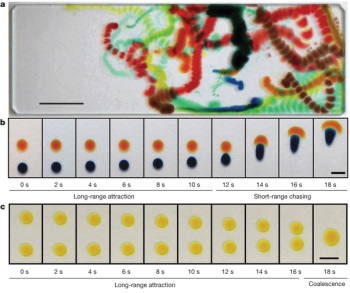Controlling the wetting behaviour of liquids on surfaces is important for a variety of industrial applications such as water-repellent coatings and lubrication. Liquid behaviour on a surface can range from complete spreading, as in the ‘tears of wine’ effect to minimal wetting as observed on a superhydrophobic lotus leaf. Controlling droplet movement is important in microfluidic liquid handling, on self-cleaning surfaces and in heat transfer. Droplet motion can be achieved by gradients of surface energy. However, existing techniques require either a large gradient or a carefully prepared surface to overcome the effects of contact line pinning, which usually limit droplet motion. Here we show that two-component droplets of well-chosen miscible liquids such as propylene glycol and water deposited on clean glass are not subject to pinning and cause the motion of neighbouring droplets over a distance. Unlike the canonical predictions for these liquids on a high-energy surface, these droplets do not spread completely but exhibit an apparent contact angle. We demonstrate experimentally and analytically that these droplets are stabilized by evaporation-induced surface tension gradients and that they move in response to the vapour emitted by neighbouring droplets. Our fundamental understanding of this robust system enabled us to construct a wide variety of autonomous fluidic machines out of everyday materials.
Nature 519, 446–450 (26 March 2015)




